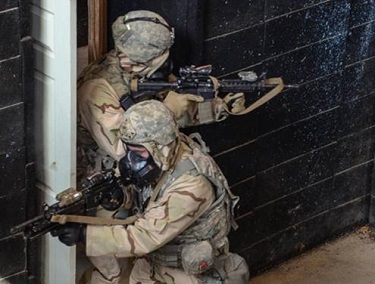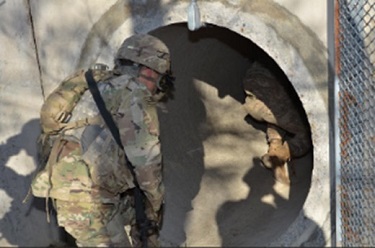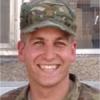Preparing General Purpose Forces for Combat in Megacities: How Conventional Units Can Best Train for Fighting in Dense Urban Terrain
Adam Scher
Team live fires in a shoot-house normally represent a basic task that is one of the key building blocks of the Army’s room-clearing battle drill. For the paratroopers of 1-508th Parachute Infantry Regiment (PIR), this basic task became complex when the battalion executed its most recent live fires and dense urban area training by employing innovative mission command technology in a chemical environment while wearing gas masks and protective suits. While 1-508th PIR is surely not the first organization to conduct live fires or train for operations in a chemically contaminated environment, our training serves as a clear example of how conventional forces can prepare themselves to operate and win in megacities under extreme environmental conditions.
Some urban warfare scholars are clamoring for the Army to establish urban specific fighting formations. MAJ John Spencer, Deputy Director of the Modern War Institute at West Point, outlines in several opinion pieces the need for a 5,000 soldier unit consisting of cyber warriors, aviators, mechanized and airborne infantry, engineers, and a myriad other enablers. These units would focus on indirect fires, information operations, and combat service support that is committed to rapidly deploying, innovating on a grand scale, and employing advanced technologies not normally fielded to conventional forces. Major Spencer identifies megacities as a future battlefield the US military would be foolish to ignore, and he is also absolutely right “that megacities will require major changes to today’s fighting vehicles, weapons, and equipment. Every aspect of the “shoot, move, and communicate” framework is challenged by the urban environment. Current systems will have to be modified, new capabilities and technologies implemented.” Additionally, he recognizes that the lack of dense urban training facilities limits the Army’s ability to train for megacity warfare. His detractors that argue these three points either ignore general trends in migration and economic development or fail to truly appreciate the complexity of dense urban terrain and what it means to the warfighter. While I concur with MAJ Spencer’s holistic diagnosis of the problem, I fear his cure, centered on the establishment of an entirely new unit, is impractical and in some ways fails to appreciate the bureaucratic challenges associated with creating, and perhaps more importantly, maintaining such a specialized unit. Further, I think the energy and effort aimed at trying to build such a particular solution reduces readiness in other combat formations and could serve to reduce grassroots-level creativity at the lowest tactical levels.
I do not disagree that an urban operations school would pay great dividends, and I do not even necessarily disagree that modified organization and unit structure could be part of a long-term future solution. Today’s battalion and brigade commanders, leading men and women into harm’s way, can’t wait for an ideal solution to be produced from the top-down. Instead, this generation of battalion and brigade commanders that spent their junior officer years in Baghdad, Kabul, Mosul, and Kandahar must find ways to address the challenges of megacities without the luxury of ‘wish-list’ novelty equipment, or dedicated schooling and training for combat in dense urban areas.
It is only within the last forty to fifty years that militaries began developing formalized doctrine for fighting inside urban centers with civilians on the battlefield that aimed at preserving critical infrastructure and protecting the civilian population. Many of those writing doctrine before the US invasions of Afghanistan and Iraq correctly identified that general purpose forces increasingly would find themselves operating in urban areas, not only to defeat an entrenched enemy, but also to preserve delivery of services, protect critical infrastructure, and secure a disaffected population.
The current fights in Iraq, Syria, and Afghanistan, exemplified by battles for cities like Mosul and Raqqa, highlighted the importance of operating in subterranean and urban terrain. Numerous media reports confirmed that coalition forces fighting to liberate Mosul discovered extensive tunnel networks. “This infrastructure allowed Islamic State fighters to creep quickly into position, then ambush advance troops from concealed locations. One commander recounted driving a tank into Eastern Mosul. He watched as dozens of Islamic State fighters quickly slipped from the street to the tunnels.” These fortified positions seemingly had significant tactical importance to the Islamic State and were riddled with booby-traps that injured and killed coalition forces, severely reducing the speed and tempo of clearing operations. “It’s like we are fighting two wars in two cities,” Col. Falah al-Obaidi of the Iraqi counterterror forces told The Washington Post. “There’s the war on the streets and there is a whole city underground where they are hiding. Now it’s hard to consider an area liberated, because though we control the surface, ISIS will appear from under the ground, like rats.” Despite recent success against ISIS, fighting a near-peer enemy in megacities like Lagos, Los Angeles, or Sao Paolo would present greater and more dangerous risks to friendly forces that can only be avoided through innovations in our mission command architecture, our operating philosophies, and our tactics techniques and procedures. Army Chief of Staff General Mark Milley “has characterized recent and current urban operations, including fighting in Aleppo in Syria, and Fallujah and Mosul in Iraq as ‘previews’ of future conflict. Those fights, while bloody, costly and destructive, hardly reach the scale of a megacity — Mosul is not equal to a neighborhood in Seoul.” Conventional forces must adapt in real time to this current reality; waiting for these ‘previews’ to become ‘primetime’ is a recipe for disaster for the conventional ground forces training for close combat.
Today’s new challenge for military thinkers is addressing the problems associated with extremely dense urban centers and their underground facilities that include transit tunnels, bunkers and other below-ground hardened facilities. According to MAJ Spencer, “a new unit would serve as the primary learning organization for the Army and the vanguard of development of planning and doctrine for fighting in megacities.” Unfortunately, current battalion and brigade commanders do not have the time to wait for this proposed sea change to Army organizational structure. Even if such a unit could be trained, equipped, and organized starting today, any dividends from their existence is three to five years away at best. Worse, what would be the opportunity cost of designing such a tailored urban-only unit? Commanders in all other formations would feel confident embracing many of the counterarguments MAJ Spencer goes to great lengths to discredit about how the US Army can avoid fighting in megacities. In fact, the urban unit actually proves this point for leaders of the more traditional non-urban units who could presumably justify not training for megacities precisely because they aren’t designated, educated, trained, or equipped like the specialized formations MAJ Spencer envisions. This would work to actually reduce the Army’s overall preparedness to fight in dense urban areas. A more comprehensive solution comes not from over-specialization, but from empowering our pre-existing combat formations with the facilities, direction, and mission command equipment to fight and win no matter the terrain.
To enhance the lethality and improve the combat readiness of our conventional formation right now, 1-508th PIR Battalion Commander, LTC Robert McChrystal, began the fielding of an integrated tactical network. Paratroopers from one company and the battalion staff employed the Android Tactical Assault Kit (ATAK) End User Device (EUD) and the Tactical Scalable Manet (TSM) waveform radio during a Joint Forcible Entry (JFE) culminating exercise at Fort Bragg in the summer of 2017. The enhanced mission command capabilities with data, voice, and chat proved extremely effective and spurred fielding to the entire battalion less than two weeks prior to the next major training event. During successful missions at the Joint Readiness Training Center at Fort Polk, Louisiana, as part of direct action rotation 18-01 in October 2017, it became apparent to the 1-508th team, the opposing force elements, and many other leaders throughout the Army that the 1-508th employment of the integrated tactical network made them exponentially more flexible and lethal when compared to similar formations operating under similar enemy and terrain conditions at JRTC. Upon return to Fort Bragg and following a review of the literature focused on growing threats facing militaries operating in megacities, LTC McChrystal searched for the next collective training opportunity that would allow his battalion to implement this network in subsurface and other dense urban environments.
With the help of the Asymmetric Warfare Group at Fort A.P. Hill, 1-508th PIR created and tested its standard operating procedures for military operations urban terrain (MOUT) for the 21st century during a comprehensive two-week training program in March 2018. The training plan focused on an operating environment which is increasingly characterized by rapid urbanization, sweeping information technology development, weapons of mass destruction, the privatization of violence, and the growing capabilities of America’s near-peer adversaries to disrupt the US Military’s mission command networks. While the dangers of such terrain, especially if chemically or biologically contaminated, are well documented, the mission command technology, doctrine, and training facilities to prepare conventional forces for such combat have not kept pace with the growing threat.

1-508 Paratroopers Execute Battle Drill 6 Live Fire in MOPP4

1-508 Paratroopers Enter a Tunnel System

1-508 Paratroopers Clear Rooms in a Simulated Chemical Lab
MOUT 2.0, as dubbed by 1-508th, is focused on fighting a uniformed enemy among the sub-surfaces and skyscrapers in dense urban areas. This type of terrain degrades communication and navigation systems that rely on line of sight connections to satellite or other antenna networks. Fighting in such a harsh and unfamiliar environment ensures that the attacker remains at a disadvantage. 1-508th PIR is training to fight and win under these conditions by executing the live fire training noted above and through the implementation of an integrated tactical network of End User Devices (EUD) operating the Android Tactical Assault Kit (ATAK) and Tactical Scalable Manet (TSM) waveform radios that enable mission command over voice, chat, and data communication in the most unforgiving of environmental conditions. These advanced waveform radios and secure but unclassified Android Galaxy smartphones are optimizing friendly unit tracking, voice and text communications, and creating a survivable tactical network for general purpose battalions. What makes this network unique is how it seamlessly integrates existing sensors like full-motion video drones, infrared cameras, and other ground sensors already employed to combat units. Furthermore, the secure but unclassified nature of the system allows for coalition partner integration and with the use of a cross-domain solution, other army ‘secret-level’ programs have access to the entire common operating picture managed by local servers at the battalion level. Most importantly the network EUDs are intuitive and employed at the team leader level without the need for lengthy training or instruction manuals to make the system accessible to general purpose forces.
Beyond the ease of use and implementation, the integrated tactical network is survivable and resilient. The TSM waveform employs software driven correction for multipath fading, known as barraging, which increase end receipt signal and reduces the probability of jamming. Furthermore, barraging allows for all radios to broadcast simultaneously, something key to overcoming the hazards of dense urban terrain both underground and in multi-story buildings. Major General Gallagher, Director of Networks, Services and Strategy, recently explained the Army’s focus on multiband radios that can incorporate innovative anti-jam solutions, multipath networks, and dynamic spectrum reallocation based on near-peer threats in dense urban terrain. Paratroopers of the 1-508th are refuting the notion that specialized urban units need futuristic equipment and proving that “short-term solutions can be as simple as replacing old server stacks with new ones one-third the size, replacing bulky metal antennas with inflatable ones, or loading new software on an off-the-shelf Android phone.” These types of bottom-up doctrinal, material, facility, and training advances risk being ignored if today’s military leaders are left waiting for MAJ Spencer’s transformation of combat units and centralized schooling.
Navigating the current and future risks associated with the contemporary operating environment will require a creative employment and fielding of resources, human capital, and an updated enterprise of mission command equipment to plan and implement realistic training opportunities to further enhance doctrine, tactics, techniques, procedures and equipment that already reside in conventional units. The AWG and the integrated tactical network enabled such training to 1-508th PIR.
Many other units across the Army are experimenting and innovating with underground and megacity operations. Training these together, doing so with an integrated tactical network, and operating under chemically contaminated conditions represent 1-508th’s small contribution to this conversation. This ongoing discussion is critically important because the previous two decades of war in Afghanistan, Iraq, and Syria created ground forces capable of sustained small-scale urban combat focused on the precision targeting of individuals that has left close combat formations ill-prepared to endure the challenges presented by megacities. Secretary of Defense Jim Mattis underscored this point in a memo outlining his vision for enhancing the lethality of ground combat units. "These formations have historically accounted for almost 90 percent of our casualties and yet our personnel policies, advances in training methods, and equipment have not kept pace with changes in available technology, human factors science, and talent management best practices." Establishing a single, urban-only, unit doesn’t address the broader concerns conveyed by the Secretary of Defense about America’s military entire close-combat enterprise. The innovation and creativity required to improve the military’s ground combat forces readiness, lethality, survivability, and resiliency in chemically contaminated dense urban terrain already exists in our current formations and should be enabled, encouraged, and resourced appropriately to empower today’s tactical leaders to exercise true mission command in a megacity combat environment.
The views expressed are those of the author and do not reflect the official position of the 82nd Airborne Division, United States Army, or Department of Defense.

